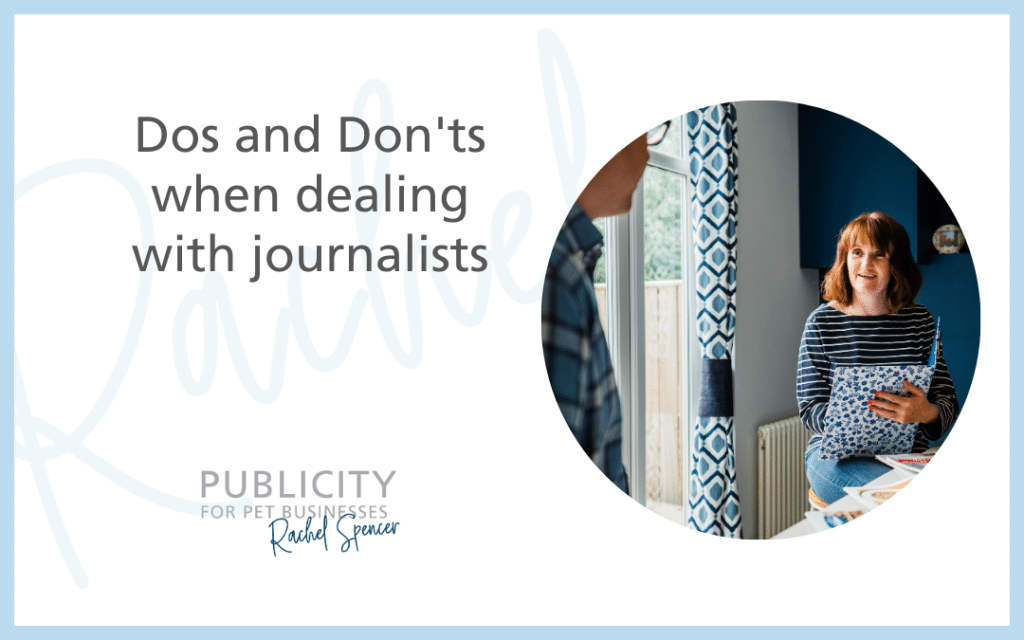Putting yourself forward to the media can be daunting when you run a business,
And having an insight into how best to approach a journalist can make a huge difference.
Getting it wrong could mean your story idea never sees the light of day.
Getting it right gives you the potential to go on to build a lasting relationship with the reporter and lots of coverage in future.
In this podcast episode I share seven dos and don’ts to follow when approaching the media.
You can listen in on the player link below or continue reading as a blog post.
I had the idea to create this episode after a huge furore over an article about puppies in the Sunday Times on February 14th 2021.
It was written by sports commentator Andrew Cotter and you can read it in full here.
In the article he shared his advice on how best to treat a puppy in their first year as a seasoned dog owner.
It prompted a lot of criticism from trainers and behaviourists who felt a professional should have been appointed to write the piece.
In his defence, Andrew had highlighted that he wasn’t qualified to give advice several times, saying, ‘I certainly don’t purport to be an expert,’ ‘Simply because I made a few videos involving dogs, people decide I must be an authority on them and that’s not the case,’ ‘There are plenty of canine experts out there – obviously vets being at the top of the tree,’ and ‘I offer these wise yet utterly unqualified words.’
I do see that readers and owners would see him as an authority, take in his suggestions and go on to use them.
However, lashing out at a writer on social media, attacking them, telling them publicly they are wrong, is not going to achieve anything.
The right thing to do is approach them privately, explain your expertise and offer yourself up as a sounding board for future stories.
This approach is far is more likely to lead to a lasting relationship and you becoming their go-to for expert comment in the future.
Now for the dos and don’ts when dealing with journalists
Do be yourself
It can be tempting to want to come across as uber qualified, knowledgeable and professional and of course you’re going to do that!
But be yourself too, show your personality and this will make you memorable.
Do have anecdotes and examples
The journalist will mostly likely ask for a story around your topic. Let’s say you’re talking about helping barking dogs.
Have a specific example of a dog you helped with their name, age, breed, the problem, the solution you provided and the emotional impact on the owner and pet.
Do have facts and figures to hand
Research your topic for some statistics before your interview that you can quote. The journalist will love you for it!
Do be passionate about your topic
Be enthusiastic. For radio, you really need to turn up your personality to get the listener’s attention.
Get excited about what you do and think of the impression you want to make on the person reading or listening, you want them to know you care.
Do have photos that fit with the story
Let’s say you’re doing a Tour De Rescue bike ride to help dogs in shelters like Dominic Hodgson did back in 2019.
To tell the story, he needed a photo of him on a bike and with a rescue dog. During the tour, he had images taken at the shelters, with dogs, talking to staff and riding the bike.
Make sure you have high resolution, decent images.
Here’s his story in the Daily Mirror. Dog trainer cycles 300 mile to help rescue dogs.
(If you’re considering a shoot, you might like to read or listen to How to plan your pet business photoshoot)
Do keep it simple
Remember you are talking to the man/woman on the street and there’s no need blind them with science.
Keep your advice simple and practical and try to give them a quick win.
Do make sure the journalist covers your topic
Before you send in an idea or pitch, check it’s going to the right person. For example, you’re far more likely to get a reply from the features editor than the politics editor.
Don’t be salesy
If you keep banging on about your business name or dropping links in to your packages or website it will make a bad impression.
If you’re on the radio live, it’s unlikely you’ll be asked back, so wait until you’re asked to share where people can learn more about you instead.
Don’t be afraid of being real
We see so much about being vulnerable, real and authentic, so don’t be afraid of sharing your flaws that make up part of you.
If you’re a dog trainer and your own dog often runs off and refuses to come back, talking about this makes you human, relatable and memorable.
Spaniel expert Hannah Antrobus shares how a video of her retrieving one of her dogs from a stream on social media prompted several bookings.
Sharing some of you builds an emotional connection.
Don’t refuse to simple background information
The journalist will be expected by their editor to include each interviewee’s age, the area they live in, their marital status and what they do for a living.
This isn’t because of sexism, or ageism, it’s for accuracy, to ensure the reader can identify the person who is being written about.
If you’re interviewed and you are asked how old you are or if you have children, do answer as it’s being asked for a reason, not because the journalist is being difficult.
Don’t complain unless it’s warranted
If the article appears and there is a typo or you don’t like the photo they have used, or they have cut your quotes down, that’s not a reason to complain.
If there is a screaming inaccuracy, then yes, of course you should raise this with the journalist and they will put it right.
Bear in mind copy is edited. I will often file 1200 word stories that can be chopped down to 300 words depending on space and this is out of my control.
Don’t be demanding
Remember media coverage is free publicity for your business, it’s not like taking out an advert so you can’t insist on certain things being said or included.
For example, links to your website or social media may be added at the bottom of the piece so people can learn more.
But you can’t insist on a link to buy a product, or book a call, or buy a ticket to an event. If you do, you may be told you need to pay for an advert.
Don’t rehearse what you want to say
If you give responses parrot fashion it will sound like you’re reading from a script which doesn’t work so well.
Have an outline of what you want to say and the points you want to cover, and try to have a natural conversation.
Don’t be precious with your knowledge
You might feel like you’re giving your best stuff away for free. The journalist is most likely to ask you to go into a lot of detail about your topic.
If you refuse to give it, they will have no choice but to find someone who will. Then you have missed an opportunity and ruined a relationship with them.
Think of all the millions of dog training books there are out there – people still use dog trainers don’t they? When you want something fixing, you call in an expert.
And if you’re quoted as an expert in the media, you’re rising above the others in your area who are not.
Like Karen Boyce from Beastly Thoughts dog training who shares how having 30 pieces of local coverage led to her training 220 pups in 2020.
You can listen to her interview here: Karen Boyce on how press coverage has helped her training business.
• If you’re planning on pitching to the press, this is what I help my clients to do in my Pets Get Visible membership.
It’s just £30 a month to join my membership, check out Is my Pets Get Visible membership right for you?
If you found this helpful, you might like How to get press coverage from Facebook groups with Jill Foster, How to write a press release for your pet business or Five places to approach with stories about your pet service business.





